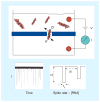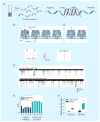Detection of miRNAs with a nanopore single-molecule counter
- PMID: 22845478
- PMCID: PMC3500609
- DOI: 10.1586/erm.12.58
Detection of miRNAs with a nanopore single-molecule counter
Abstract
miRNAs are short noncoding RNA molecules that are important in regulating gene expression. Due to the correlation of their expression levels and various diseases, miRNAs are being investigated as potential biomarkers for molecular diagnostics. The fast-growing miRNA exploration demands rapid, accurate, low-cost miRNA detection technologies. This article will focus on two platforms of nanopore single-molecule approach that can quantitatively measure miRNA levels in samples from tissue and cancer patient plasma. Both nanopore methods are sensitive and specific, and do not need labeling, enzymatic reaction or amplification. In the next 5 years, the nanopore-based miRNA techniques will be improved and validated for noninvasive and early diagnosis of diseases.
Figures



Similar articles
-
Nanopore single-molecule detection of circulating microRNAs.Methods Mol Biol. 2013;1024:255-68. doi: 10.1007/978-1-62703-453-1_21. Methods Mol Biol. 2013. PMID: 23719958
-
Rapid electronic detection of probe-specific microRNAs using thin nanopore sensors.Nat Nanotechnol. 2010 Nov;5(11):807-14. doi: 10.1038/nnano.2010.202. Epub 2010 Oct 24. Nat Nanotechnol. 2010. PMID: 20972437
-
Programming nanopore ion flow for encoded multiplex microRNA detection.ACS Nano. 2014 Apr 22;8(4):3444-50. doi: 10.1021/nn406339n. Epub 2014 Mar 26. ACS Nano. 2014. PMID: 24654890 Free PMC article.
-
Nanotechnology-based strategies for the detection and quantification of microRNA.Chemistry. 2014 Jul 28;20(31):9476-92. doi: 10.1002/chem.201402649. Epub 2014 Jul 2. Chemistry. 2014. PMID: 24989446 Review.
-
Isothermal Amplification for MicroRNA Detection: From the Test Tube to the Cell.Acc Chem Res. 2017 Apr 18;50(4):1059-1068. doi: 10.1021/acs.accounts.7b00040. Epub 2017 Mar 29. Acc Chem Res. 2017. PMID: 28355077 Review.
Cited by
-
An overview of microRNAs.Adv Drug Deliv Rev. 2015 Jun 29;87:3-14. doi: 10.1016/j.addr.2015.05.001. Epub 2015 May 12. Adv Drug Deliv Rev. 2015. PMID: 25979468 Free PMC article. Review.
-
The Transition from Cancer "omics" to "epi-omics" through Next- and Third-Generation Sequencing.Life (Basel). 2022 Dec 2;12(12):2010. doi: 10.3390/life12122010. Life (Basel). 2022. PMID: 36556377 Free PMC article. Review.
-
Multi-physics simulations and experimental comparisons for the optical and electrical forces acting on a silica nanoparticle trapped by a double-nanohole plasmonic nanopore sensor.Sens Biosensing Res. 2023 Aug;41:100581. doi: 10.1016/j.sbsr.2023.100581. Epub 2023 Aug 11. Sens Biosensing Res. 2023. PMID: 39239382 Free PMC article.
-
Alpha-hemolysin nanopore allows discrimination of the microcystins variants.RSC Adv. 2019 May 10;9(26):14683-14691. doi: 10.1039/c8ra10384d. eCollection 2019 May 9. RSC Adv. 2019. PMID: 35516306 Free PMC article.
-
Clinical Application of Circulating MicroRNAs in Parkinson's Disease: The Challenges and Opportunities as Diagnostic Biomarker.Ann Indian Acad Neurol. 2020 Jan-Feb;23(1):84-97. doi: 10.4103/aian.AIAN_440_19. Epub 2020 Jan 21. Ann Indian Acad Neurol. 2020. PMID: 32055127 Free PMC article. Review.
References
-
- Kim VN, Han J, Siomi MC. Biogenesis of small RNAs in animals. Nat Rev Mol Cell Biol. 2009;10:126–139. A comprehensive review of small RNAs including miRNAs, siRNAs and piRNAs in terms of biogenesis pathways and their regulations, along with their functions at both the genome and the transcriptome level. - PubMed
-
- Lee RC, Feinbaum RL, Ambros V. The C. elegans heterochronic gene LIN-4 encodes small RNAs with antisense complementarity to lin-14. Cell. 1993;75:843–854. The first publication that identified a small RNA encoded by the LIN-4 locus that was associated to the developmental timing of the nematode Caenorhabditis elegans by binding in the 3′ untranslated region (UTR) of LIN-14 mRNA and negatively modulating the protein Lin-14. - PubMed
-
- Wightman B, Ha I, Ruvkun G. Posttranscriptional regulation of the heterochronic gene LIN-14 by lin-4 mediates temporal pattern formation in C. elegans. Cell. 1993;75:855–862. - PubMed
Website
-
- miRBase. http://microrna.sanger.ac.uk.
Publication types
MeSH terms
Substances
Grants and funding
LinkOut - more resources
Full Text Sources
Other Literature Sources
